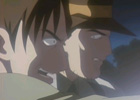Crest of the Stars by Kuzu Ryu Sen
| Seikai no Monshou | ||
| Also Known As: CotS, Crest | ||
| Genre: Action/Drama | ||
| Format: 13 Episodes | ||
| Allegiance: Sunrise/WOWOW/Bandai Visual | ||
| Director: Nagaoka Yasuchika | ||
| Vintage: 1999 | ||
| Intelligence Agency Report by: Kuzu Ryu Sen | ||
| At the age of 10, Jinto Lin was forced to watch as his father Rock sold out their home world of Martine to the Humankind Reich of the Abh, becoming a traitor and pariah to the populace as a result. In return, Rock became the new magistrate of the star system, and as his son, Jinto became Abh nobility. After seven years of learning the “Way of the Abh,” Jinto is ready to journey to the Abh capital Lacmhacarh to serve his mandatory term in the Abh Star Forces. Assigned to escort him to the capital is a young Pilot Trainee named Lafiel, serving aboard the patrol ship Gauthloth. When the Gauthloth encounters unidentified craft during the journey, Jinto and Lafiel are evacuated as non-combatants for precautionary reasons, and are forced to find their own way to Lacmhacarh. | ||
|
|
||
| Field Agent Report by: Kuzu Ryu Sen | ||
| Plot Characters Impact Visual Audio |
9.50 9.00 9.50 8.50 8.50 |
|
| Overall | 9.25 | |
Crest of the Stars is the first part of the Stars Series, which as of this date also contains Banner of the Stars and Banner of the Stars II, based on the books of the same name by Morioka Hiroyuki. So popular were the novels in Japan that Morioka-san’s book had to be reprinted three times within the first two months. Seeing the success of the novels, the staff working on the anime decided very wisely not to mess with a winning formula, and chose instead to build the anime upon what Morioka-san had already established in his novels: outstanding characters, a solid plot, and above all, an enthralling universe that entraps the viewer.
Crest of the Stars has two main strengths. The first is the fictional universe that serves as the setting, in particular, the attention to detail used during the construction of the Abh is simply amazing. Many details regarding their culture and military are given, and some even become key plot devices as well. The second is that, unlike many science-fiction anime, this show focuses much more on dialogue rather than action. Even during combat, there is a much greater emphasis placed on the interactions of the crew, rather than the ships shooting at each other. As a result of this emphasis on dialogue, and the skill of the writers, the characters of Crest of the Stars are either well fleshed out, initially have great personalities to compensate, or both. In particular, Jinto and Lafiel, the two leads, create a great chemistry together, and with all the characters they encounter as well.
The only real problem is that the whole show felt like it was a chapter of some greater whole. While the plot was very solid, the actual amount of the story covered seemed rather insignificant compared to what was happening in the universe aside from it. There were some greater issues that the plot hadn’t even begun to dent. Although this problem can be partially excused because a sequel was planned from the start, the lack of screen time damages an otherwise fantastic show. Aside from that, the only issues were some moments of low quality animation, and the classic single colour sci-fi explosions were problematic on and off throughout the show.
Overall, the animated adaptation of Morioka Hiroyuki’s hit novel is an overwhelming success. The amazingly intricate and detailed universe in Crest of the Stars, along with the powerful characters, creates an enjoyable watching experience even for non-science-fiction fans. Things are looking good for the Stars Series if Banner of the Stars and Banner of the Stars II are anything like Crest of the Stars.




